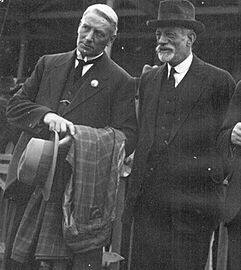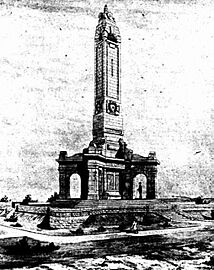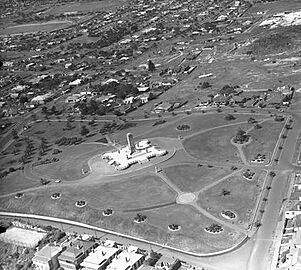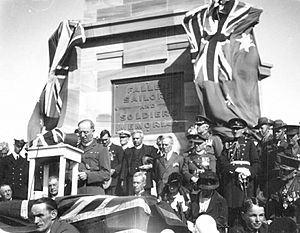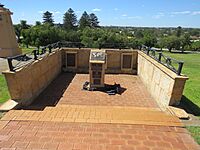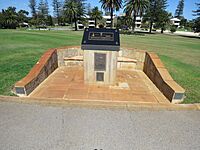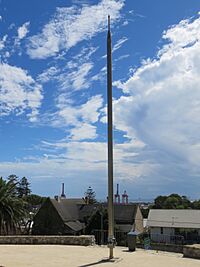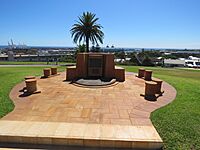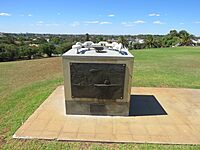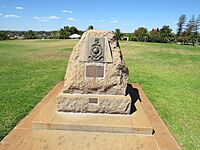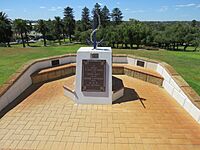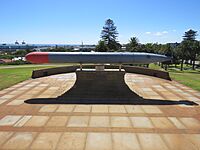Fremantle War Memorial facts for kids
Quick facts for kids Fremantle War Memorial |
|
|---|---|
| operated by the City of Fremantle | |
 |
|
| For Fremantle servicemen and servicewomen | |
| Unveiled | Armistice Day (11 November), 1928 |
| Location | 32°03′08″S 115°45′26″E / 32.05229°S 115.757237°E near Fremantle, Western Australia
|
| Designed by |
|
|
Building details
|
|
| General information | |
| Type | Monument |
| Design and construction | |
| Main contractor | Pietro Porcelli |
| Type | State Registered Place |
| Designated | 28 August 2001 |
| Reference no. | 3956 |
The Fremantle War Memorial is a special place in Fremantle, Western Australia. It sits on top of Monument Hill, a large public park. This memorial is made up of a tall, pointed stone called an obelisk. It also has eight smaller memorials around it.
The memorial looks out over Fremantle Harbour. It was built in 1928 by the Fremantle Town Council. Its main purpose is to remember the brave people from Fremantle who served in the First World War and other conflicts.
Contents
Where to Find the Memorial
The War Memorial is located on Monument Hill in Fremantle. This hill is about 43 meters (141 feet) above sea level. From here, you can see amazing views! You can look west towards the Indian Ocean, Garden Island, and Rottnest Island. To the east, you can see the Darling Ranges. It's the highest natural spot between the ocean and the ranges.
Monument Hill was known for its great views a long time ago. The area around the memorial is mostly homes. However, Fremantle Prison, Christian Brothers College, and John Curtin College of the Arts are also nearby. Several roads surround the park, and Solomon Street runs through the middle, allowing cars to access it.
This land is very important. It's called the Monument Hill Memorial Reserve. This means its purpose cannot be changed without permission from the government. The site is also listed on the Western Australian Register of Heritage Places. This listing recognizes its beautiful views, green spaces, and how it helps people feel connected to their community.
A Look Back: History of the Memorial
Early Days of Monument Hill
Before the memorial was built, a different obelisk stood on Monument Hill in 1874. Surveyors and sailors used it as a "trig point" to help them measure land and navigate. The hill was even called Obelisk Hill back then.
In the 1890s, after gold was discovered in Western Australia, many people moved to Fremantle. Some lived in temporary "canvas towns" on Monument Hill. In 1904, the hill became a public park called Obelisk Reserve. Workers then started to quarry limestone from the hill. They also planted trees, built paths, and added benches for people to enjoy.
Building the Main Memorial
In 1921, the Fremantle Town Council created a committee. Their goal was to build a special monument to remember the men who joined the army and navy from Fremantle. They first planned for a 65-foot (20-meter) tall obelisk.
Raising money for the memorial was a big task. People held flower shows and sold local goods. By October 1922, they had collected about £1,600, which is like A$66,000 today. The committee also realized they needed a better road to the hill to bring building materials.
In 1923, the committee, led by Frank Gibson and William Watson, worked hard to get more donations. Even though fundraising was slow, they decided to start building the memorial anyway. Architects J.F. Allen and C.H. Nicholas helped with the design. They even made some changes to save money, like using concrete instead of steel.
The famous Italian sculptor Pietro Porcelli was in charge of building the monument. He had also created other important statues in Fremantle. The main tower of the memorial was planned to be 60 feet (18 meters) tall, with an 18-foot (5.5-meter) base. This would make it 85 feet (26 meters) tall in total.
The Unveiling Ceremony
The memorial was finished and officially opened in 1928. First, a special tablet on the main column was dedicated on Anzac Day (April 25) 1928. The main unveiling ceremony happened later that year on Armistice Day (November 11). This important event was led by Robert McMillan, who was the Lieutenant-Governor of Western Australia at the time.
Adding More Memorials
Over the years, more memorials were added to honor those who served in other conflicts.
- In 1948, plans began for gates to remember those from the Second World War. These gates, with granite pillars and bronze panels, were opened on Anzac Day in 1963.
- A torpedo memorial was unveiled in 1967. It remembers United States Navy submariners who died at sea during World War II.
- In 1972, a memorial for Allied submarine crews in Fremantle during World War II was unveiled. It even includes a periscope from a real submarine!
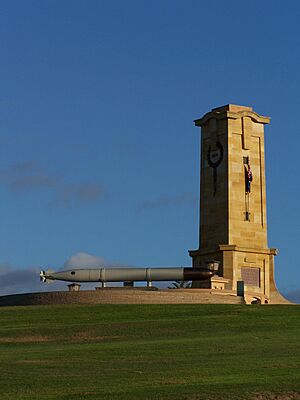
- A plaque was added in 1975 for those who died in conflicts like the Malayan Emergency, Korean War, Borneo Confrontation, and Vietnam War.
- In 1984, a memorial honored those who served on Australian corvettes in World War II.
- A plaque from the Netherlands Ex-Servicemen's Association was unveiled in 1991. It remembers Dutch service members based in Fremantle.
- A ship's anchor memorial was added in 1994 for Royal Navy personnel from World War II.
- Later, memorials were dedicated to the Australian Merchant Navy (1995) and the Royal Marines (1996).
List of Memorials
Here are some of the memorials you can find at the Fremantle War Memorial:
What Happens at the Memorial Today
Every year, special services are held at the Fremantle War Memorial. These happen on Anzac Day (April 25) and Remembrance Day (November 11). These days are important for remembering those who served and sacrificed.
The main memorial is designed in a unique way. At sunrise, the year "1914" lights up. At sunset, the year "1919" lights up. These years mark the beginning and end of the First World War. This special feature reminds people of a line from the Ode of Remembrance:
At the going down of the sun
and in the morning,
we will remember them.
On Anzac Day, the shadows from the sun line up perfectly with these dates.


